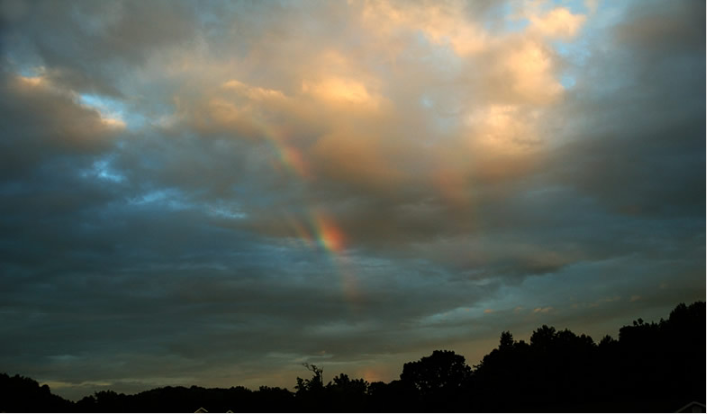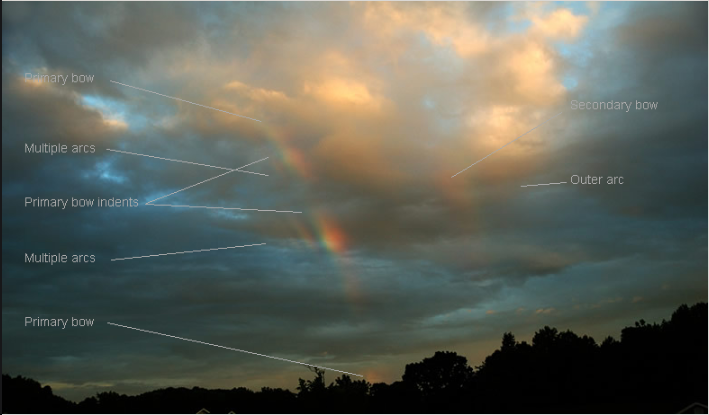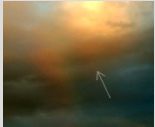Multiple Rainbows, Statesville North Carolina
Multiple Rainbows: A Rare Atmospheric Phenomenon in Statesville, North Carolina
On the evening of July 29, 2006, Charles Tilley witnessed a truly remarkable and rare display of multiple rainbows in Statesville, North Carolina. The event lasted only a few minutes before sunset, resulting in the bows being beautifully reddened. What made this occurrence particularly unusual were several distinct features that set it apart from typical rainbows.
-
Diverging Fans of Colored Arcs: One of the remarkable aspects of the multiple rainbows in Statesville was the presence of two diverging fans of narrow colored arcs inside the primary bow. These arcs created a mesmerizing visual effect, adding complexity to the already stunning display.
-
Indents in the Primary Bow: Another intriguing characteristic of the Statesville rainbows was the presence of indents in the primary bow where the sets of multiple arcs were most widely separated. These indents added a unique and distinctive pattern to the overall appearance of the rainbows.
-
Faint Colored Arc Outside the Secondary Bow: Perhaps one of the most intriguing aspects of this phenomenon was the very faint colored arc observed outside the secondary bow. This arc, known as a secondary supernumerary, is exceptionally rare and indicates specific conditions within the rain shower.
So, what exactly was happening to create such a spectacle in the skies above Statesville?
Typically, multiple bows or reflection bows are produced when sunlight reflects off sheets of water. However, in this case, the nearest water sources were quite far away, making it unlikely that reflection bows were responsible for the multiple rainbows observed. Furthermore, these bows appeared too narrow and were incorrectly positioned for reflection bows.
Although violent showers can sometimes produce twinned bows, the Statesville rainbows did not resemble them, and there were no reports of violent showers or hail during that time. This ruled out the possibility of violent showers being the cause of the phenomenon.
The key to understanding the multiple rainbows in Statesville lies in the presence of the secondary supernumerary, the faint and broad arc observed outside the secondary bow. This secondary supernumerary indicates that the raindrops involved in this event had two distinct characteristics: a narrow range of sizes and a diameter of less than 0.4mm (400 microns).
The existence of small raindrops with a narrow range of sizes helps explain the presence of multiple arcs inside the primary bow. These arcs, known as supernumeraries, are not their usual vibrant colors due to the sunset reddened rays. The fan-like spacing of these supernumeraries is a result of the raindrop sizes varying smoothly across a small part of the sky during the localized showers.
By estimating the sizes of the raindrops involved, researchers have been able to simulate and compare the actual supernumerary spacings observed in Statesville. These simulations indicate that as the drop size decreases, the main primary bow shrinks slightly, leading to the two indents observed. The simulations also reveal that the widely spaced arcs were visible due to the small drop sizes and the absence of blue light, which would typically reduce contrast. The fact that the drops were of closely similar size further contributed to the visibility of these outer arcs.
In summary, the multiple rainbows observed over Statesville on that extraordinary evening were a result of several localized showers with raindrops smaller than 0.4mm and a very narrow range of sizes. These unique conditions gave rise to bright primary supernumeraries and an exceptionally rare secondary supernumerary. The smooth variation in drop size across specific areas of the sky produced supernumeraries with a fan-like structure, making this sight truly remarkable and infrequently witnessed.
It is worth noting that such occurrences of multiple rainbows are relatively rare, and witnessing them is a testament to the incredible beauty and complexity of atmospheric optics.


Multiple Bows
Charles Tilley saw this very rare display in the early evening of July 29, 2006 at Statesville, North Carolina.
Mouse over the image for labeled features.
Image ©Charles Tilley, shown with permission.
The display occurred for a few minutes before sunset and the bows are consequently reddened. The unusual aspects were (1) the two diverging fans of up to 3-4 narrow coloured arcs inside the primary, (2) Indents in the primary at the levels where the sets of multiple arcs were most widely separated and (3) a very faint coloured arc outside the secondary bow.
What was happening?
Multiple bows, reflection bows, are sometimes produced by sunlight reflected off sheets of water. However, the nearest water was 28 km to the West and 56 km to the SouthEast. The multiple bows were also too narrow and wrongly placed for reflection bows. Violent showers sometimes produce the enigmatic ‘twinned bows’ but Statesville bows do not look like them and there were no violent showers or hail.

Secondary supernumerary
The clue is the faint and broad arc outside the secondary bow. It is a secondary supernumerary. Supernumeraries inside the primary bow are not unusual but a supernumerary to the secondary is very rare. That it is present and so bright tells us that in that region the raindrops (1) had a narrow range of sizes and (2) they were less than 0.4mm (400 micron) diameter .G.P. Konnen, ''Appearance of the supernumeraries of the secondary rainbow in rainshowers, J Opt Soc Am A, 4, 810-816 (1987)..
The existence of small raindrops with a narrow range of sizes also explains the multiple arcs inside the primary. They are supernumeraries to the primary bow. They are not their usual colours because they are produced by sunset reddened rays.
Why the fan-like spacing? When raindrops are less than ~0.4mm dia the spacing of supernumeraries widens as the drops get smaller. Usually showers have their smallest drops at their edges. What we have here are localised showers in which the drop size varied smoothly from small drops to larger ones across a small part of the sky and so produced the fan-like structure.
We can estimate the sizes of the drops involved. The angular scale of the image can be found from the red, orange, and green separations of the main primary and secondary bows. That then allows rainbows simulations by Airy scattering theory to be superimposed and compared with the actual supernumerary spacings.

The simulations used a distribution of drop sizes around each mean value characterised by a standard deviation of 15%. The simulations match the spacings of the upper and lower parts of the ‘fan’ reasonably.
The upper simulation tells us more. As the drop size decreases the main primary bow shrinks slightly. This is the reason for the two indents.
Why were so many supernumeraries visible? Usually you see one or two. Here, the arcs were widely spaced because of the small drop sizes. The reddened light stopped blue light from reducing the contrast. And the drops were of closely similar size. When the size spread in the simulations was increased to 20% the outer arcs were not visible.
In summary: That evening over Statesville there were several localised showers that produced fragments of a primary and secondary rainbow. Some showers had raindrops smaller than 0.4mm with a very narrow range of sizes. These produced bright primary supernumeraries and a very rare secondary supernumerary. The drop size varied smoothly across two areas of sky and so produced supernumeraries of smoothly changing spacing that gave them a unique fan-like structure. A sight like this does not occur very often!
Note: this article has been automatically converted from the old site and may not appear as intended. You can find the original article here.
Reference Atmospheric Optics
If you use any of the definitions, information, or data presented on Atmospheric Optics, please copy the link or reference below to properly credit us as the reference source. Thank you!
-
<a href="https://atoptics.co.uk/blog/multiple-rainbows-statesville-north-carolina/">Multiple Rainbows, Statesville North Carolina</a>
-
"Multiple Rainbows, Statesville North Carolina". Atmospheric Optics. Accessed on April 19, 2024. https://atoptics.co.uk/blog/multiple-rainbows-statesville-north-carolina/.
-
"Multiple Rainbows, Statesville North Carolina". Atmospheric Optics, https://atoptics.co.uk/blog/multiple-rainbows-statesville-north-carolina/. Accessed 19 April, 2024
-
Multiple Rainbows, Statesville North Carolina. Atmospheric Optics. Retrieved from https://atoptics.co.uk/blog/multiple-rainbows-statesville-north-carolina/.